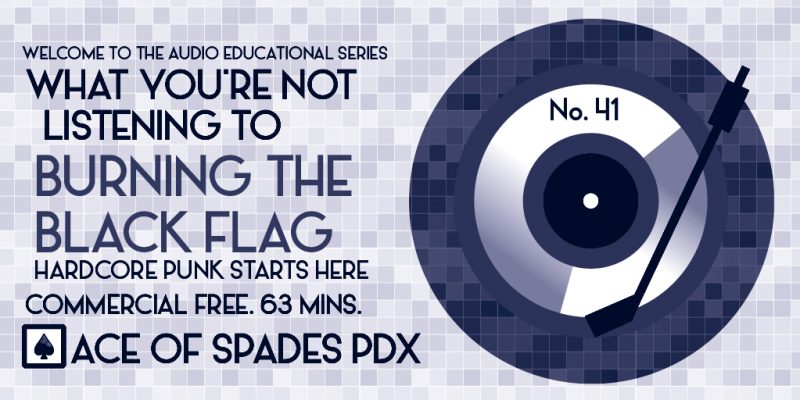Podcast: Play in new window | Download | Embed
The Clash were billed by their major label marketing department as “the only band that matters”, not even realizing they were already being surpassed by the most indie and most hardcore of them all. #blackflag #punk #hardcore #SST
NOTE: THIS PROGRAM AND POST CONTAIN IMAGES, SUBJECT MATTER AND LANGUAGE SOME MAY FIND OBJECTIONABLE. THIS IS YOUR CHANCE TO OPT OUT.
There is a great deal of nostalgia that surrounds the Los Angeles punk and hardcore scene of the early 1980’s. Many people who weren’t there or lived in more well-off neighborhoods romantically talk about the good ‘ole days and how cool it was. There is one thing they do get right, more often than not: it was pure. It was pure chaos it what it was. So, at least they are partially correct.
Being an outsider in Los Angeles wasn’t hip, fun or trendy in the early-to-mid 1980’s. In fact, it pretty much not only got you ostracized, you were constantly hassled by your parents for listening to such “filth”, your teachers looked down upon you as if you had tuberculosis, you got hassled by “cool kids” for being a freak, which included those in the scene who felt you didn’t fit in and and the worst of all, you were always a target for the LAPD, sometimes violently, especially if you were poor, as I was.

Black Flag perfectly encapsulated that period of time and place in their music. Their records, a mix of punk, metal, free form jazz, spoken word and avant-garde noise meant they didn’t get played on the radio; even an episode of the doctor drama Quincy derided the local punk scene. It truly was you against the world. Black Flag were the voice of the poor, forgotten and dispossessed by everyone. They made some of the most intense records ever created, and yet they really didn’t even see a dime for their constant hard work.
The band was started by Greg Ginn out of all places, the South Bay area of Los Angeles, which was not only my birthplace but my home until I was 17 in 1986. Some of the nearby schools were home to numerous preppies in the recently developed condominium areas (gentrification was just beginning), but in most others, it was home to the poor and people of color who could not afford to move out. The area had a reputation for violence and shady characters, and the part of the South Bay I lived in the most, Wilmington, which is where the Los Angeles harbor is, was filled with gangs, homeless camps and drug dealers. The only thing worse were the cops, who knew they were far from the watchful eye of downtown, and treated the place like their own hunting safari.
“SST was formed to put out the first Black Flag record. Basically, there wasn’t anyone else to do it.”
Greg Ginn, founder, Black Flag and SST Records
Even though their notice among the police and rock critics was growing, they ended up with a bad business deal that pretty much forced them on the road for the next 3 years after their debut, Damaged, was released in 1981. This is the Black Flag most people romanticize about, not realizing they were living hand-to-mouth in a van, touring across the country where they were often stiffed for money owed by promoters or not even being allowed to play, leaving them truly starving many times.
After a riot at a show opening for the Ramones in 1984 on the Sunset Strip when the police attacked patrons leaving the Palladium (I know, I was there), the band started to show cracks. Through their ever-evolving line-up, which at times included Hispanics and a female bass player, they never could seem to break into the big time, or at least make enough money to stay alive. They laid the foundation of all alt-rock labels that would follow with SST, which Ginn founded just to release the band’s recordings, but at a price far too high.

As Punk rock become more conservative with the rise of racist skinheads into the scene, the band decided to call it a day. I can’t say I blame them whatsoever. But, I would be absolutely lying if I told you I wasn’t grateful; indeed, even though I was some young queer junkie living in a broken down trailer with no water or electricity in an underdeveloped area known for scrapyards alongside the many homeless whom I would sit next to at the Beacon Street Mission on Broad Street, Black Flag reminded me that I had value, that someone was actually listening, that someone gave a damn and that I too could have a voice. A powerful one.
First Part
- Nervous Breakdown, 1979, Nervous Breakdown EP
- Rise Above, 1981, Damaged
- Shed Reading (Rattus Norvegicus), 1984, Family Man
- Six Pack, 1981, Six Pack EP
- Revenge, 1980, Jealous Again
- Three Nights, 1984, My War
- Damaged I, 1981, “Louie Louie” single B-Side
- Damaged II, 1981, Damaged
Second Part
- Slip It In, 1984, Slip It In
- The Crazy Girl, 1985, In My Head
- Loose Nut, 1985, Loose Nut
- Drinking and Driving (live), 1986, Who’s Got The 10 1/2 Inch?
- TV Party, 1981, TV Party EP
Finale
- You’re Not Evil, 1984, Slip It In
Love to you all.
Ben “Daddy Ben Bear” Brown Jr.
Host, Producer, Audio Engineer, Researcher, Webmaster and Writer
“Copyright Disclaimer Under Section 107 of the Copyright Act 1976, allowance is made for ‘fair use’ for purposes such as criticism, comment, news reporting, teaching, scholarship, and research. Fair use is a use permitted by copyright statute that might otherwise be infringing. Non-profit, educational or personal use tips the balance in favor of fair use.”
